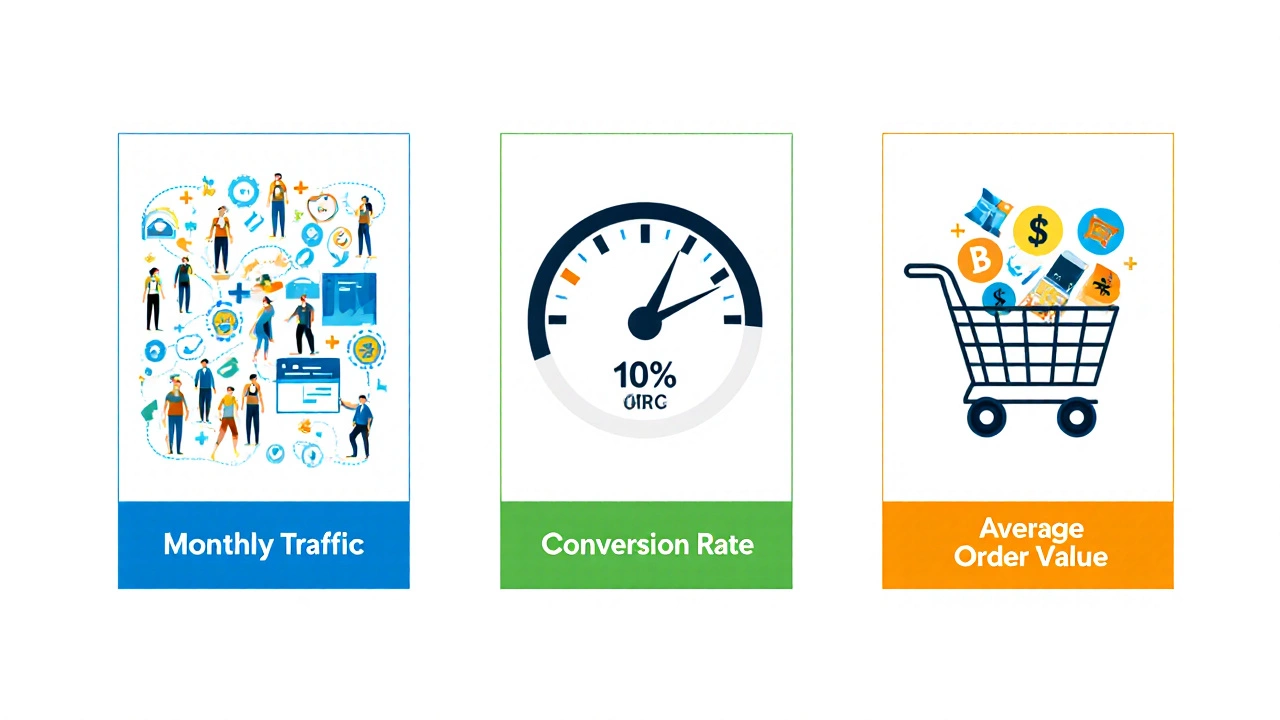eCommerce Monthly Income Calculator
Calculate Your Monthly Revenue
Estimate your revenue using the formula: Revenue = Traffic × Conversion Rate × AOV
Input Your Metrics
Your Results
Tips to Improve
Ever wondered why some online shops seem to rake in six figures every month while yours barely covers the hosting bill? The gap often comes down to understanding the average eCommerce monthly income and the factors that push a store past the median. Below you’ll get the numbers that matter in 2025, a step‑by‑step way to estimate your own earnings, and practical tips to lift your profit line.
What "average eCommerce monthly income" really means
eCommerce is a digital commerce model where businesses sell goods or services over the internet. When analysts talk about the average monthly income of an eCommerce store, they usually refer to gross revenue earned in a typical month, not the net profit after expenses.
This distinction matters because a shop can pull in $50,000 a month but, after ad spend, fulfillment costs, and platform fees, the real take‑home could be a fraction of that.
How the average is calculated
Most industry reports start with Gross Merchandise Volume (GMV), the total value of all goods sold before deductions. They then break GMV into three core drivers:
- Average Order Value (AOV) - the mean amount a customer spends per transaction.
- Conversion Rate - the percentage of website visitors who complete a purchase.
- Monthly traffic - the total number of unique visitors a store attracts.
Using the simple formula Revenue = Traffic × Conversion Rate × AOV, analysts aggregate data from thousands of stores on platforms like Shopify, WooCommerce, and Amazon Marketplace to compute a median monthly figure.

Benchmarks by store size and platform (2025)
| Store Tier | Shopify | WooCommerce | Amazon Marketplace |
|---|---|---|---|
| Starter ( <$5k GMV ) | $350 | $300 | $400 |
| Small ( $5k‑$50k GMV ) | $2,200 | $1,800 | $2,500 |
| Mid‑size ( $50k‑$500k GMV ) | $15,800 | $13,400 | $18,200 |
| Enterprise ( >$500k GMV ) | $96,400 | $84,100 | $112,300 |
These numbers come from a 2024‑2025 survey of 2,300 stores across North America and Europe. Notice how the Amazon tier consistently tops the chart-its massive buyer base tends to boost traffic, even though sellers face higher commission fees.
Key factors that swing the monthly income
Even within the same tier, two stores can differ wildly because of four main levers:
- Traffic quality. Organic search visitors usually convert at 2‑3%, whereas paid‑search traffic can push conversion to 5% if the ads are well‑targeted.
- Conversion optimization. Simple tweaks-like adding trust badges, streamlining checkout, or offering a single‑click “Buy Now” button-can lift conversion by 0.5‑1 percentage point, which translates into thousands of dollars.
- Average Order Value (AOV). Upsells, bundles, and free‑shipping thresholds often raise AOV by 10‑30%.
- Cost structure. Platform fees (Shopify ~2.9% + 30¢, WooCommerce plugins, Amazon referral fees) and fulfillment costs erode the gross figure. Knowing the exact percentages lets you turn a gross number into real profit.
Put together, these levers explain why the median earnings for a mid‑size Shopify store sit at $15,800, while a similarly sized WooCommerce shop might report $13,400-the former typically enjoys higher paid‑media spend and a richer app ecosystem for conversion tools.
Estimating your own average monthly income
Here’s a quick calculator you can run in a spreadsheet:
- Gather your monthly unique visitors (e.g., Google Analytics → Users).
- Determine your conversion rate (Purchases ÷ Users). If you lack data, use the industry average: 2.2% for organic, 4.5% for paid.
- Find your average order value (Revenue ÷ Number of Orders). If you sell a mix of items, calculate a weighted average.
- Plug into the formula: Estimated Revenue = Visitors × Conversion Rate × AOV.
- Subtract platform fees (e.g., Shopify 2.9% + $0.30 per order) and an estimated fulfillment cost of 5‑7% of revenue to get a rough net monthly income.
Example: 12,000 visitors, 3% conversion, $68 AOV.
Revenue = 12,000 × 0.03 × 68 = $24,480.
Platform fees ≈ $710, fulfillment ≈ $1,400 → Net ≈ $22,370.
That $22k lands you squarely in the “mid‑size” bracket, giving you a realistic benchmark to compare against the table above.
Practical ways to push the average higher
If you’re sitting below the median for your tier, try these fast‑acting tactics:
- Invest in SEO. Ranking on page1 for three core product keywords can add 1,500-2,500 organic visitors per month, which at a 2% conversion yields $3k-$5k extra revenue.
- Retarget abandoned carts. Email sequences with a 5% recovery rate can lift monthly sales by 2‑4%.
- Introduce tiered bundles. A “buy two, get 10% off” bundle often pushes AOV up by 12%.
- Test one‑click checkout. Reducing checkout steps from 5 to 3 can improve conversion by 0.4‑0.8%.
- Negotiate shipping rates. A 10% shipping cost reduction directly adds to profit, especially for high‑volume stores.
Each of these moves addresses one of the four levers we discussed earlier, turning a modest monthly figure into a robust, scalable income stream.
Quick takeaways
- The global median eCommerce monthly income in 2025 sits around $2,200 for small stores and $96,400 for enterprise‑level shops.
- Traffic, conversion rate, and AOV together explain over 80% of revenue variance.
- Shopify stores tend to earn 10‑15% more than equivalent WooCommerce sites, largely due to built‑in conversion tools.
- Use the simple formula (Visitors × Conversion × AOV) to estimate your own earnings and compare against the benchmarks.
- Lean on SEO, retargeting, bundling, checkout optimization, and shipping cost cuts to boost income quickly.
Frequently Asked Questions
What counts as “average” eCommerce income?
Most reports use the median of gross monthly revenue across thousands of stores, separating them by size and platform. Median is preferred over mean because it reduces the impact of outliers-tiny hobby shops and massive brands.
How does gross revenue differ from net profit?
Gross revenue is the total sales amount before any costs. Net profit subtracts platform fees, payment processing, shipping, advertising, and overhead. A store might earn $50k gross but only $12k net after those deductions.
Is Shopify really better for revenue than WooCommerce?
On average, Shopify stores report 10‑15% higher monthly revenue. The edge comes from a richer app ecosystem, built‑in checkout optimization, and stronger hosting performance, which together boost conversion rates.
Can I use the traffic‑conversion‑AOV formula if I sell services?
Yes. Replace "Average Order Value" with "Average Service Sale Value" and the same calculation applies. Just make sure you track unique visitors and completed bookings accurately.
What’s a realistic conversion rate for a new store?
New stores often see 1‑1.5% conversion from organic traffic. Adding targeted paid ads can lift it to 3‑4% within the first six months, especially if the checkout is optimized.
